April 28, 2021
From the Vault: What About CONSUELO?
A guest post by Maynard Bray and N.G. Herreshoff

by Maynard Bray and N.G. Herreshoff (where italicized)
This little cat yawl that was N.G. Herreshoff's initial foray into the design of cruising sailboats has always intrigued me as she's such a complete departure from his earlier work. Launched for himself in 1883, she's the very first sailing craft considered substantial enough to be entered into the construction list of the Herreshoff Mfg. Co. (HMCo.) since its founding five years before. She carried hull number 400, kicking off the thousand-plus that would follow over the next 63 years. (Numbers 1 to 399 were intended for power craft.) Drawings back in those early days were few and none specifically created for CONSUELO were known to exist. Until recently, that is, when a rough construction plan came to light—drawn in pencil by Nathanael Herreshoff (N.G.H.) himself. Discovered at the same time were several of his studies leading up to this boat. With these documents at hand, a better idea of what CONSUELO was like is possible.
CONSUELO sailing in Newport Harbor August 19, 1889, then owned by Pierre Lorillard; image Courtesy Historic New England, Stebbins Photographic Collection
Catamarans were N.G.H.'s personal watercraft before 1882 and in later life he claimed to have enjoyed sailing them more than any other type. Indeed, they were wicked fast and gave a full measure of spirited sailing, but offered no shelter save for a tent pitched on the floor of their shallow oval cockpits for sleeping. Now that N.G.H. had reached 34 years of age, he may have had enough of this kind of sailing. He may even have been thinking of marriage and a more suitable watercraft in which to take his bride. In any event, for reasons we can only presume, he decided to go in for more comfort and sacrifice a good bit of speed when designing his new boat—a 32-foot, full-keel cat yawl that he christened CONSUELO. For whom she was named remains a mystery.
To C.H.W. Foster, in 1932, N.G.H. wrote: "... in 1882, I wanted something to cruise in comfortably, and decided to build a cruising boat. Hearing of the English yachts being fitted with outside lead, I decided to try it on my cruiser, and designed CONSUELO, cat yawl rigged. She was 32' overall, 29' waterline, 8'8" beam, and 5'6" draft, and had full headroom under a flush deck. All ballast was of lead, and outside. I went the limit for a cruising boat, the first time. She had very comfortable accommodations and proved very fast, compared to boats of her day. She was even fast in light winds with a small sail spread of only 665 square feet, which she would carry when the average craft would come down to two or three reefs. In underwater type she was the forerunner of GLORIANA but not as to above water. ... CONSUELO's particular fault was 'hobby horsing' in a seaway. ..."[1]
[1] Herreshoff, Nathanael Greene. Letter to Charles H. W. Foster, dated March 6, 1932. Quoted in Foster, Charles H. W. The Eastern Yacht Club Ditty Box, 1870-1900. Norwood, Mass., 1932, p 139-141.
In Recollections, in 1934, he recorded: "Wanting to try a low ballasted, heavy type of cruising boat, I designed, in the fall of 1882, the cat-yawl CONSUELO. This boat was thirty-two feet overall, about twenty-nine feet waterline, eight foot eight inches beam, and five feet two inches draft and had about six and one-half tons lead ballast, all outside. She was a very unusual boat in many ways, having many features that were new and designed [e]specially for this boat, some of which were: the rig, the steering gear, the windlass, companionway doors, skylight fittings, the swinging hood shelter over [the] cockpit, outside lead straps [made of bronze] to hold lead directly to timbers, and many others. The hull was quite light, but never complained of weakness.
"The planking and deck were double planked [and] cemented with white lead or shellac (I don't remember which) and the outer deck layer was mahogany. Internally, there was a full set of hanging knees between deck beam[s] and timbers, and below these, she was completely ceiled. All cabin and deck trimmings were of mahogany. She was deep and high sided enough to give head room. She had two berths over [the] settees by [with] swinging backs forward, and two berths under [the] aft deck at [the] sides of [the] cockpit [and] a water tank and ice chest under [the] cockpit. [There was a] toilet room, and forward of that a quite roomy galley. The rig was a novelty to these waters. The main mast was stepped quite near the bow and without stays, and consequently heavy. The mast carried a gaff sail, like a catboat, with shortened boom, but it had a pole end aloft and this allowed for carrying a quite efficient topsail. Abaft the main boom was a mizzen mast that was stepped aft of the rudder stock. This was supported by stays and it carried a mizzen sail of one-half dimension of the mainsail and consequently one-fourth its [the mainsail's] area. As I recollect, the main boom was twenty-seven feet and [the] sail about seven hundred and thirty [sic; 610] square feet. The topsail had about eighty-five square feet, so for ordinary summer sailing, there was about nine hundred and ten [sic; 853] square feet. Besides these sails, there was a spinnaker with [a] twenty-seven foot boom, and a trysail for heavy weather.
"The yacht was fitted with two sets of davits, and I always carried two boats and never had to swing them over the deck, for the high sides and heavy ballast never allowed the lee rail to approach the water. This boat proved really fast, even in light airs. In fresh or strong breezes, she would work out to windward of all bay craft anywhere near her size. I always sailed her single-handed, even with topsail and spinnaker set. Her only fault was "hobby-horsing" in a steep sea, and this, of course, endangered her heavy, unstayed mast.
"This yacht was sold to Louis [sic; Pierre] Lorillard of Newport, in 1887. I did not intend selling her, but was urged to name a price, which was grabbed at." [2]
[2] Herreshoff, N. G. "Some of the Boats I Have Sailed In." Written 1934. In: Pinheiro, Carlton J. (ed.). Recollections and Other Writings by Nathanael G. Herreshoff. Bristol, 1998, p. 53-54
N.G.H. designed this boat in his usual way—by carving a half model (two study models in this case before he settled on the third and final one), and measuring its shape which then got scaled up for the full-sized boat. He made the model in the fall of 1882, measured it that October, and the new cruiser was launched the following April. He and Clara DeWolf were wedded the day after Christmas in 1883, some eight months later.
According to Forest & Stream of December 6, 1888, "Mr. Herreshoff used her a great deal for singlehand cruising about Bristol and Newport, sailing her alone, but taking his wife and family with him, the boat being very roomy and well arranged below." [3]
[3] Anon. "The Cat Yawl Empress." Forest and Stream, December 6, 1888, p. 399
After regretfully selling CONSUELO, N.G.H. moved immediately to create his next, slightly larger cruiser named CLARA after his wife. Sadly, CONSUELO is long gone, but CLARA survives in the Herreshoff Marine Museum's collection.
About the Hull Shape
Hulls of this shape were becoming common during the 1880s, so CONSUELO's shape was not exactly the breakthrough that N.G.H.'s GLORIANA's turned out to be a decade later. In the 1880s, premier designers such as Edward Burgess and A. Cary Smith, as well as C.P. Kunhardt, the opinionated yachting editor of the bi-monthly magazine Forest & Stream (F&S), were turning out keel cruisers of this size and type regularly. F&S, in fact, mounted a campaign advocating this type of wholesome cruiser while at the same time ridiculing the shallow sandbagger types of New York as being easily capsized "death traps." Boats like CONSUELO combined the virtues of the narrow "plank on edge" non-capsizable English cutters with the wider keel boats native to Massachusetts Bay and points farther east. She was high at the bow, low at the stern and almost straight in between. Her underwater profile ran in a continuous convex curve from her nearly plumb stem all the way aft where, still as a fair line, it looped completely around the rudder.
That smiley shape of the underwater profile, rounding upward as it does toward the rudder, was typical of 1880s keel yachts and may have been the result of adding a cast lead ballast keel as an appendage to a traditional straight-keeled hull—an evolutionary stage in transitioning from an inside ballasted hull built up from a long and straight timber keel to an underwater shape more influenced by performance than by ease of construction. In any event, CONSUELO's keel and its floor timbers were deep enough for N.G.H. to stand fully upright under the deck beams. Her beam was moderate: a little over a quarter of the overall length.
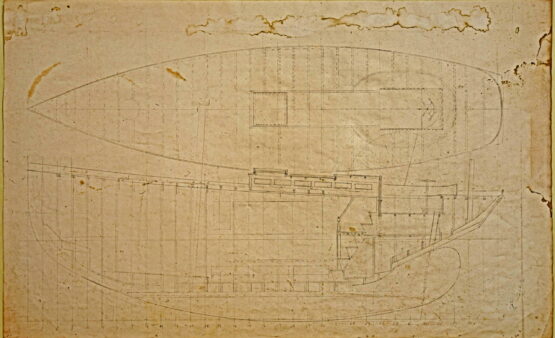
N.G.H. drew this plan in pencil indicating how CONSUELO was to be built. With frames spaced 12" apart, it's easy to determine other measurements; access courtesy Halsey C. Herreshoff
An N.G.H. study drawing that led to CONSUELO. The 'midship drawing with its facing settees and swing-down berths would later apply to CONSUELO; access courtesy Halsey C. Herreshoff
About the Half Model
N.G.H. carved two half models of the same general size and shape before settling on the third and final one which became CONSUELO. Both of the study models had longer forward overhangs, and he gave one of them a gammon knee and bowsprit, intending her to be rigged as a cutter having a single mast well back from the stem. For this one, he drew a rough arrangement and three sectional views. In the end, however, he opted for a nearly plumb stem that married better with the cat yawl rig he'd chosen for his new cruising boat. For all three half models, N.G.H. drew their profiles, their sections, laid out their curve of areas, and calculated their displacement. For measuring underwater areas, it's not surprising he had a planimeter at hand since that device was in common use in evaluating steam engines.
CONSUELO's half model (and the other two before it) is completely fair to its extremities, as was the hull that resulted from it, and this is true of almost all of N.G.H.'s sailing craft. Doing so not only creates a lovely, sculpted shape without the creases from rabbet lines and slab-sided backbones, but also reduces the wetted surface. This makes for faster boats in light airs when skin friction amounts to most of the resistance as an object moves through the water. Creating a fair hull all the way out to its profile is the easy and logical way to carve a half model, but in building the full-size boat it means hollowing out deadwood and ballast keels—extra labor that many boatbuilders were unwilling to expend.
Half model of CONSUELO currently on display in the N.G. Herreshoff Model Room
About the Offsets
A study of the offset book for CONSUELO reveals that N.G.H. had some means, even this early, of accurately measuring half breadths at every frame, and at evenly-spaced waterlines that were generally a foot apart except where tight curves called for closer spacing for accuracy. Half breadths and other measurements were expressed in feet, inches, and eighths—the accepted standard subsequently used by almost every yacht designer and naval architect. Whatever this early model-measuring device consisted of, it was replaced a few years after CONSUELO by the device that's now in the model room of the Herreshoff Marine Museum.
Noted within the booklet that contains CONSUELO's offsets, is that her transom was set up about 2½" farther aft than was intended. For this change, N.G.H. drew a dashed outline and wrote down measurements, doubtless taken from the hull itself for the record since no such change shows in the model.
About the Rig
The cat yawl rig was what made CONSUELO unique among her peers, and by using it, it's clear that N.G.H. planned on handling her without any help. Other yachts of this type carried full cutter rigs that needed a crew, even on a yacht as small as 32 feet. The idea of the cat yawl rig might have come from the sailing canoes then being featured in F&S. But the catboats N.G.H. had grown up with and which his brother John (J.B.H.) had produced so many of were a natural starting point, and adding a mizzen for weathercocking the boat was, therefore, only a small step from the Herreshoffs' then-favored cat rig.
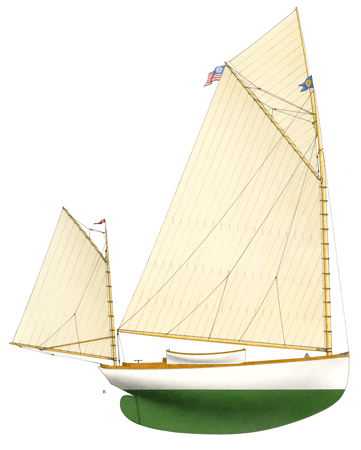
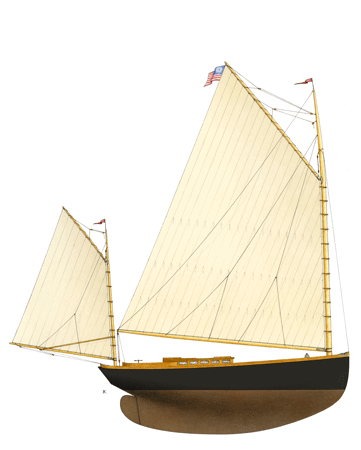
Kathy Bray's renderings of CONSUELO, the white-hull with hoisted tender representing N.G.H.'s ownership and the black hull showing how she looked after a subsequent change in ownership and topside color; courtesy Kathy Bray
Both masts carried gaff sails, and as a cat yawl the heavy unstayed mainmast stood way forward near the stem and the mizzen mast stepped almost at the transom. A strut kept its boom from lifting, and so greatly eased the sheet tension that there was no need for a boomkin. The mainmast which scales from the drawing at about 9-1/2" in diameter had but a single forestay since the mast was too far forward for shrouds to be effective. Its upper end where the peak halyard gets its support was noticeably tapered. Both photos clearly indicate bending, meaning that the forestay, without a strut, wasn't doing much. Had carbon fiber been available in 1883, building CONSUELO's mast from that material would have made it lighter and stiffer, reducing both the boat's hobbyhorsing and the bending of its masthead.
N.G.H. wrote to his son L. Francis May 9, 1936, "As I recollect Consuelo's mast was under 10" dia with a mainsail about 675 [sic; 610] (square)' and 6 tons lead outside! Clara's mast about 10 1/2", having sail over 750 (square)'. The latter was sprung and showed weakness the 3rd year and replaced. Consuelo's was not broken till about 20 years old. These masts were entirely unstayed, but of course care was taken in rough weather. ..." [4]
[4] Mystic Seaport Museum, L. Francis Herreshoff Collection, Box 17, Folder 12: Letter from N. G. Herreshoff to L. F. Herreshoff.
For its day, CONSUELO's 768 square feet of working sail was thought scant—at least by N.G.H. The mainsail carried most of the area, the mizzen spreading only a quarter of that amount. (N.G.H., ever the mathematician, designed the sails to be proportional to each other, with the four sides of the mizzen exactly half those of the main.) The sails, judging from the two surviving photos, were beautifully made, with narrow panels parallel to the leech. No battens are visible, yet there's no significant leech curl.
Instead of traditional wooden mast hoops, N.G.H. used metal ones, and rather than traditional wooden gaff jaws, the photos show a metal saddle. No lacing can be seen on either the gaff or boom, so the sail track and slides that N.G.H. invented could have been used as early 1883.
Forest & Stream remarked favorably about N.G.H.'s cat yawl rig: "One of the most practical and serviceable rigs for singlehand sailing is the 'main and mizzen,' or as it is usually called in America, the 'cat yawl' rig, the same that is generally used in canoes. Though common enough on small craft in England, it is comparatively a novelty here, its introduction about five years ago being due to Mr. N. G. Herreshoff, of Bristol, R. I., at least he was the first to test the rig thoroughly and put it into working shape.
"Though fitted with partners for cutter rig she was tried with a large mast in the bows and a small one on the counter, the sails both being boom and gaff. Under this rig she handled admirably, as the many yachtsmen who have seen her picking her way through a dense fleet of yachts in Newport Harbor can testify, and the change to cutter rig was never made."[5]
[5] Anon. "The Cat Yawl Empress." Forest and Stream, December 6, 1888, p. 399
N.G.H. not only considered a cutter rig for CONSUELO and made a preliminary drawing for it, but he also sketched her with fully-battened, bat-wing sails like those he actually tried on CLARA. As with the cat-yawl rig itself, it appears to me that the bat-wing idea came from the sailing canoes that showed up so often in Forest & Stream. Despite speculating on other ways to rig CONSUELO, it seems that she remained a cat yawl throughout N.G.H.'s ownership. After his success with that rig on CONSUELO, N.G.H. also rigged the designs that followed her as cat yawls—namely COQUINA, CLARA, WRAITH, ROMP, ALICE II, PELICAN, and GANNET. Beginning with GLORIANNA in 1891, however, N.G.H.'s emphasis shifted to racing, and for that, yachts with headsails proved more successful.
About the Layout
"[She] had full headroom under a flush deck...She had very comfortable accommodations...She had two berths over [the] settees [with] swinging backs forward, and two berths under [the] aft deck at [the] sides of [the] cockpit [and] a water tank and ice chest under [the] cockpit. [There was a] toilet room, and forward of that a quite roomy galley." [6]
[6] Herreshoff, N. G. "Some of the Boats I Have Sailed In." Written 1934. In: Pinheiro, Carlton J. (ed.). Recollections and Other Writings by Nathanael G. Herreshoff. Bristol, 1998, p. 53-54
She was virtually flush decked with only a low and narrow trolley-car type trunk cabin like a miniature of those of the later New York 30s, with five windows and one raised panel each side. At a width of only 30" it barely extended beyond the companionway hatch, and because it was so narrow there was nearly three feet of deck on each side to accommodate CONSUELO's two tenders.
"I wanted something to cruise in comfortably." [7] It almost seems as if N.G.H. designed this cruiser from the inside out and decided to live with whatever the boat's outward appearance came to be. The cabin sole rested directly on the floor timbers—just as low as it possibly could—and thanks to the rising sheerline, full headroom carried forward into the galley despite the sole there being slanted uphill. Her symmetrical, side-to-side layout set the stage for many of N.G.H.'s designs that followed, consisting of facing settees with swing-down berths above them bordered by a chest of drawers or a cabinet, and with a paneled bulkhead separating that space from the galley and head area forward. Aft of the "living space," and aft of the companionway ladder, was a "flat" that could be used for stowage or for extra sleeping. Where today you'd find an engine, an icebox and water tank sat — underneath the aforesaid "flat" and aft of the ladder. Stairway, actually, would be a better description than ladder since there were risers and handrails and fancy newel posts that accented the cabin's Victorian ambiance.
[7] Herreshoff, Nathanael Greene. Letter to Charles H. W. Foster, dated March 6, 1932. Quoted in Foster, Charles H. W. The Eastern Yacht Club Ditty Box, 1870-1900. Norwood, Mass., 1932, p 139-141
The yachting press thought well of CONSUELO: "Her interior is finished in the most elegant manner" according to the Bristol Phoenix on launching day April 14, 1883.[8] On April 16, 1885, Forest & Stream wrote: "Below her accommodations are surprising, as the room is not cut up by bulkheads. The finish is very fine, being all in mahogany. She has good headroom, a light and roomy forecastle, wide lockers in cabin, and above them folding berths on the Pullman plan. Under the deck, at after end of cabin is a large platform used for stowage, with room for a couple of beds."[9]
[8] Anon. "Successful Launchings." Bristol Phoenix, April 14, 1883
[9] Anon. (W. P. Stephens). "The Herreshoff Works at Bristol." Forest and Stream, April 16, 1885, p. 236, 237
About the Ballast
"Hearing of the English yachts being fitted with outside lead, I decided to try it on my cruiser... I went the limit for a cruising boat, the first time."[10] The limit indeed! N.G.H.'s 12,283-pound cast lead ballast keel gave this 21,400-pound boat a remarkable ballast ratio of close to 60%. There was only trimming inside ballast, and thus began his practice of using 100% outside ballast in all subsequent designs. For them to float as they should on their designed waterlines, this meant elaborate calculations for weights—an exercise that many designers didn't bother with; instead using lighter ballast keels, and after launching, bringing the boat down to her lines with bilge ballast. The difference is stability. Herreshoff boats with their lower centers of gravity could carry more sail before reefing. I'm pretty certain that CONSUELO's hull weighed less than other boats of her size, but since no weight calculations are known to exist, this can't at this time be quantified. It seems there was a slipup somewhere along the way because N.G.H. noted on one of his drawings that a half-ton chunk lead had to be cut off the aft end of her ballast keel so that she'd not trim by the stern. As time went on, N.G.H.'s weight estimates improved, so this kind of post-launching adjustment for him became rare. CONSUELO's lead ballast was simple, and similar to the keels of her contemporaries—level and flat on top with straight, flaring sides. The sophisticated ballast keel castings that Herreshoffs are so well known for came later.
[10] Herreshoff, Nathanael Greene. Letter to Charles H. W. Foster, dated March 6, 1932. Quoted in Foster, Charles H. W. The Eastern Yacht Club Ditty Box, 1870-1900. Norwood, Mass., 1932, p 139-141
N.G.H. secured the heavy lead keel to the hull not only with the usual bolts but with outside straps of bronze let in flush on each side—another feature that would continue to show up on his later designs and which he emphasized the need for in his Rules for Wooden Yacht Construction.
CONSUELO's rudder stock was wooden, not bronze as you might expect. And she steered with a horizontal wheel, not a tiller. For watertightness, the stock operated inside a metal sleeve that was flanged onto the keel timber. Both stock and sleeve came well above the waterline, with the stock continuing on upward through the cockpit sole where it was six-sided and capped by a quadrant with gear teeth cut into it that engaged the pinion of the vertical steering wheel shaft. (CLARA has the same setup.) F&S picked up on this system: "The steering gear is peculiar, an invention of the owner. The head of the rudder stock is fitted with a brass segment, lying horizontally under the cockpit floor, in which gears a brass pinion on a vertical shaft supported by a standard. The steering wheel, on the upper end of this shaft, may be locked by a slight motion, so as to secure the helm in any position, while it may be as easily released, a great feature in singlehanded sailing."[11]
[11] Anon. (W. P. Stephens). "The Herreshoff Works at Bristol." Forest and Stream, April 16, 1885, p. 236, 237
Nearly identical steering setups were used on CONSUELO and CLARA: wooden rudder stock, toothed quadrant clamped to its head, vertical shaft with a steering wheel at its top and a small pinion gear at its heel that engaged the quadrant; detail from CLARA drawing above, access courtesy Halsey C. Herreshoff
About Hull Construction
"The hull was quite light, but never complained of weakness. The planking and deck were double planked [and] cemented with white lead or shellac (I don't remember which) and the outer deck layer was mahogany. Internally, there was a full set of hanging knees between deck beam and timbers, and below these, she was completely ceiled."[12]
[12] Herreshoff, N. G. "Some of the Boats I Have Sailed In." Written 1934. In: Pinheiro, Carlton J. (ed.). Recollections and Other Writings by Nathanael G. Herreshoff. Bristol, 1998, p. 53-54
Planking, according to N.G.H.'s notes, varied in thickness, becoming thinner as it rose up the hull from the keel to the deck, another effort to keep the weight down low. The garboards, it appears, were 1-1/8" thick, the broadstrakes above them were 1", and the total thickness of the double planking from there to the sheer was 7/8" likely consisting of a 3/8" inner and a 1/2" outer layer. (Tapered frames came later.) At the deck edge, the roughed-out 'midship sectional sketch shows an early version of the Herreshoff's bulging sheerstrake that gives more secure fastening of the covering board to the hull.
It's lean picking for drawings of these early boats (no file clerk and no blueprint machine yet) so we don't know as much about how CONSUELO was built or fitted out as we'd like. She was preceded by dozens of catboats modeled and built (but never depicted on plans) by J.B.H. in the 1860s and '70s before N.G.H. became his partner, and some of those construction details surely show up in CONSUELO—in the way in which the mainmast was supported, for example. ALICE, too, built shortly after CONSUELO and on display as a relic at Herreshoff Marine Museum, sheds light on this. Given how heavy their solid masts were and how big their rigs, the step and partners for both boats look to my eye as if they should be stouter. But those are just the kinds of structures whose proportions had proven to work—and one can't argue with success.
Instead of a full-length sheer clamp each side connecting the hull with the deck, in the middle of this boat N.G.H. used a hanging knee at each of the frame/deck beam intersection where those members were butted instead of lapped. He used the same in CLARA, so I presume CONSUELO's hanging knees were also of cast bronze. Sheer clamps were employed on both boats forward and aft of the hanging knees.
N.G.H. never lost his attraction to flush-decked hulls, drawing them up as proposals late in life, urging his son L. Francis to consider them, and two years before he died, recommending that Linton Rigg so revise his proposed yacht despite the resulting appearance:
"You mention in the former letter you appreciate artistic beauty and see no excuse for ugly things. In which I agree and beside a[sic] fully agree the old saying that 'handsome is that handsome does'.
"I should by all means make the boat a 'flushdecker' and place the sheer line about as I have shown. This will give very nearly standing height in cabin, and so very much head room and air over sleeping transoms, makes the construction simpler and stronger and better in most every way you can think of excepting being ugly to what you are accustomed to look at. - But handsome is that handsome does. Fit hanging knees under each deck beam and no clamp, but the waterway substantial enough to give a bind and desired fore & aft strength. With both waterway & fender strake being substantial the planking in topside can be lighter."[13]
[13] Herreshoff, N.G. Letter to Rigg, T. Linton. Herreshoff Collection, access courtesy Halsey C. Herreshoff. Correspondence, Folder 94, formerly 137. 1937-03-18
About the Windlass
As one of the features he mentions as having been especially designed for CONSUELO, N.G.H. includes the anchor windlass, a duplicate of which survives on the foredeck of CLARA. By sliding the upper shaft to port, its gear teeth engages the rope drum, and by sliding it the other way, the anchor chain's wildcat comes into play. A removeable crank handle fitted into each end of the upper shaft, allows either one- or two-person operation.
N.G.H. designed a special, hand-cranked, chain-or-rope anchor windlass for CONSUELO, then had another made for CLARA. Note: CLARA's windlass is missing the wildcat that would originally have been on the port side; artifact currently on display at HMM
N.G.H.'s pride in his own ingenuity, along with sharp criticism for his son's, shows in his (unanswered) letter to L. Francis when commenting on the latter's windlass design for the power cruiser WALRUS: "Do you remember the windlass I designed for 'Consuelo', in 1882-3, and used on several small craft afterward? I have just been counting up mentally the total number of pieces it contained, and I make it 20. Yours has 130 or more, and Consuelo's windlass had two features that yours has not. 1st the chain could be hauled when there was a rope fast to gypsie head, - 2nd, had two cranks and therefore could be worked by two men."[14]
[14] Mystic Seaport Museum, L. Francis Herreshoff Collection, Box 17, Folder 6: Letter from N. G. Herreshoff to L. F. Herreshoff
About the Davits & Tenders
"The yacht was fitted with two sets of davits, and I always carried two boats and never had to swing them over the deck, for the high sides and heavy ballast never allowed the lee rail to approach the water." [15]
[15] Herreshoff, N. G. "Some of the Boats I Have Sailed In." Written 1934. In: Pinheiro, Carlton J. (ed.). Recollections and Other Writings by Nathanael G. Herreshoff. Bristol, 1998, p. 53-54
Yes indeed, CONSUELO carried a pair of lovely lapstrake round-bottomed rowboats on davits—a most unusual setup even in those days for so small a mother ship. No CONSUELO-specific davit drawings have survived, but in general HMCo.'s small-boat davits were forged from 1-1/16" round bar tapered to 7/8" at the outboard end before being flattened to take the hoisting block. They stepped inside a length of pipe that was hidden and secured below deck. These davits, like the mainmast, could benefit from using today's carbon fiber construction.
CONSUELO's two lapstrake, round bottomed Whitehall-type rowboats were between 10 and 12 feet long and built with the usual HMCo. delicacy: thin cedar planks over steamed oak frames, and riveted. Examples of such elegant little boats can be seen and examined at the Herreshoff Marine Museum. One of CONSUELO's tenders had a sail as evidenced by a surviving roughed-out sail plan.
Detail of Stebbins photo from above, showing davits and tenders aboard CONSUELO in 1889; image courtesy Historic New England Stebbins, Photographic Collection
About the Dodger
Instead of calling them dodgers, the collapsible bow-supported shelters were known as melon tops or tarpaulin hoods, and CONSUELO had such a device that spanned cockpit's full width and included the companionway.
In June 1887, Forest & Stream wrote "... A valuable feature of all the Herreshoff launches is the hood or buggy top of oiled drill, stretched over bent wood frames hinged so as to be swung into any position. The cover can be raised sufficiently on either side to break the wind while leaving the boat open; it can be raised to cover half or more of the cockpit for protection from rain while running, or it can be swung entirely over the cockpit, making a complete roof by night. The same idea is adaptable to sailing craft, but so far as we know it has only been fitted to one, the cat-yawl CONSUELO, owned and sailed by Mr. N. G. Herreshoff. In this yacht the steering is done by a horizontal bar on an upright standard in place of a tiller or wheel, and over the after [sic; forward] part of cockpit a hood is fitted so as to protect the steersman from the weather. ..." [16]
[16] Anon. "Steam Yacht Building At Bristol." Forest and Stream, June 2, 1887, p. 424
About Dropboards
It appears that CONSUELO first used the pick-me-up companionway dropboards that became common on subsequent Herreshoff yachts. They're not depicted clearly on her penciled construction drawing, but you can see them on CLARA's rendering. They're a slick idea in that they're always there and on standby instead of rattling around in a locker; you grab the aftermost (upper) board, lift it until it engages the lower one (which runs in separate grooves in the doorway) after which both boards rise together until they close off the opening.

Detail of dodger from N.G.H. penciled construction drawing of CONSUELO; access courtesy Halsey C. Herreshoff
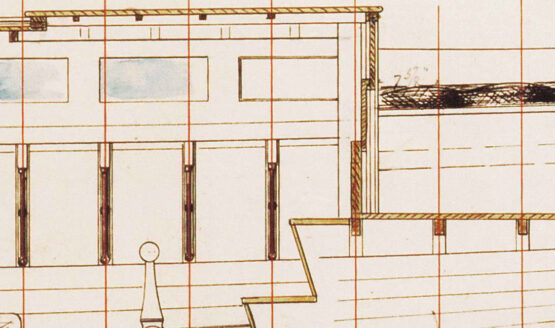
Detail from CLARA's construction drawing showing sliding dropboards became a HMCo. standard, CONSUELO's being their first use; access courtesy Halsey C. Herreshoff
About the Metal Blocks
N.G.H. says he designed the closed-shell bronze blocks for CONSUELO that, afterwards, became the standard for yachts of many sizes and are still being made today by J.M. Reineck & Son. Their smooth, convex shell castings that contain the sheave axle can be polished until they look like jewels, and with a variety of end attachments, can fit about any situation.
About the Hollow Cleats
Another hardware item that, according to N.G.H., made its first appearance on CONSUELO were the four-bolt, cast bronze, hollow cleats with space enough between their legs to serve as a fairlead or chock. There's also enough spread between fastenings to resist a sideways pull. It's not surprising that this design has become so widely copied. They, too, are available from Reineck and elsewhere.
About the Bulwark
Surrounding the deck edge in place of a toerail, N.G.H. fitted a 5" or 6" high plank-on-edge bulwark topped by a small cap that gave it a finished look. Herreshoff "signature" bow chocks were set into the bulwark near the stem while, aft, at the quarters, the bulwark curved continuously, making for a very graceful stern, despite the transom itself being completely flat. As was probably true of the cabin trunk and deck, the bulwark was doubtless varnished.
About Selling
In a letter dated February 9, 1887, N.G.H. wrote the following to broker M. Hubbe & Co.:
Dear Sirs,
I have had no idea of putting the Consuelo on the market but it has occurred to me that I might offer her for a limited time, which would give me time to replace her before the yachting season. I will therefore offer her until the 15th of March, 1887 at $2,500 net to me, delivered here afloat in perfect order. She is 32-1/2 ft overall, 28-1/2 ft waterline, 8’8” beam 5’9” draft of water, has 6-1/4 tons of lead on her keel, and 1/4 ton lead inside. Is built about as well as a boat can be and should last a lifetime if properly used. There is no iron fastening, all being copper and bronze, double planking, double deck, outside being of mahogany, is perfectly tight in every part. There is 5’11” headroom under the deck beams, has a fine skylight and cockpit, bronze steering gear & windlass. Completely furnished and everything is in as good condition as new. Sails new last summer. 2 small boats & davits &c.
Rig is peculiar and has given me perfect satisfaction. She has never been beaten by any craft of her size that sail with stationary ballast and she has proved a hard customer for our racing boats. She is under cover and a customer can see her by applying to me. [17]
[17] Herreshoff, N.G. Letter to M. Hubbe, New York City. February 9, 1887. Herreshoff Collection, access courtesy Halsey C. Herreshoff
About Buying
Dear Mr. Herreshoff,
I realize I'm over a century late in responding to your appealing advertisement for your cat yawl CONSUELO, and I expect she's no longer available. If, by chance, she is, I'd be more than willing to meet your asking price of $2,500. I've long admired this boat and can imagine myself at her steering wheel (or steering bar, if that's how she’s fitted) beating to windward without having to tend jib sheets or running backstays. From what I've observed, I should be able to see over her tenders when they are hoisted on their davits. I am curious as to what kind of finish her deck has on it, given that it is of mahogany. Would it be varnished, oiled, or just left to weather?
In sailing, it would help to get a few pointers from you on how to set and handle the spinnaker and its long pole. Single-handed, which I understand you do often, using the spinnaker must take considerable skill and forethought. The topsail I'm unsure of as well, so instruction as to how best to raise and lower it would also be appreciated.
I apologize for burdening you with these questions, but my goal is to learn to sail CONSUELO as well as you do, or at least make the attempt. And I'm very sorry for not writing this letter 134 years ago.
Yours truly,
Maynard Bray
Author's Note: I'm very grateful for the assistance and access to his grandfather's records, drawings and correspondence that's been provided to me over many years by Halsey Herreshoff. I'm equally indebted to the staff of the Herreshoff Marine Museum and especially to my friend Claas van der Linde and his Herreshoff Catalogue Raisonné. Without those resources, this article could never have been written. —MB
Maritime historian Maynard Bray has authored or co-authored many books on the subject of wooden boats and especially Herreshoff yachts. He lives in Brooklin, Maine.
[1] Herreshoff, Nathanael Greene. Letter to Charles H. W. Foster, dated March 6, 1932. Quoted in Foster, Charles H. W. The Eastern Yacht Club Ditty Box, 1870-1900. Norwood, Mass., 1932, p 139-141.
[2] Herreshoff, N. G. "Some of the Boats I Have Sailed In." Written 1934. In: Pinheiro, Carlton J. (ed.). Recollections and Other Writings by Nathanael G. Herreshoff. Bristol, 1998, p. 53-54
[3] Anon. "The Cat Yawl Empress." Forest and Stream, December 6, 1888, p. 399
[4] Mystic Seaport Museum, L. Francis Herreshoff Collection, Box 17, Folder 12: Letter from N. G. Herreshoff to L. F. Herreshoff.
[5] Anon. "The Cat Yawl Empress." Forest and Stream, December 6, 1888, p. 399
[6] Herreshoff, N. G. "Some of the Boats I Have Sailed In." Written 1934. In: Pinheiro, Carlton J. (ed.). Recollections and Other Writings by Nathanael G. Herreshoff. Bristol, 1998, p. 53-54
[7] Herreshoff, Nathanael Greene. Letter to Charles H. W. Foster, dated March 6, 1932. Quoted in Foster, Charles H. W. The Eastern Yacht Club Ditty Box, 1870-1900. Norwood, Mass., 1932, p 139-141
[8] Anon. "Successful Launchings." Bristol Phoenix, April 14, 1883
[9] Anon. (W. P. Stephens). "The Herreshoff Works at Bristol." Forest and Stream, April 16, 1885, p. 236, 237
[10] Herreshoff, Nathanael Greene. Letter to Charles H. W. Foster, dated March 6, 1932. Quoted in Foster, Charles H. W. The Eastern Yacht Club Ditty Box, 1870-1900. Norwood, Mass., 1932, p 139-141
[11] Anon. (W. P. Stephens). "The Herreshoff Works at Bristol." Forest and Stream, April 16, 1885, p. 236, 237
[12] Herreshoff, N. G. "Some of the Boats I Have Sailed In." Written 1934. In: Pinheiro, Carlton J. (ed.). Recollections and Other Writings by Nathanael G. Herreshoff. Bristol, 1998, p. 53-54
[13] Herreshoff, N.G. Letter to Rigg, T. Linton. Herreshoff Collection, access courtesy Halsey C. Herreshoff. Correspondence, Folder 94, formerly 137. 1937-03-18
[14] Mystic Seaport Museum, L. Francis Herreshoff Collection, Box 17, Folder 6: Letter from N. G. Herreshoff to L. F. Herreshoff
[15] Herreshoff, N. G. "Some of the Boats I Have Sailed In." Written 1934. In: Pinheiro, Carlton J. (ed.). Recollections and Other Writings by Nathanael G. Herreshoff. Bristol, 1998, p. 53-54
[16] Anon. "Steam Yacht Building At Bristol." Forest and Stream, June 2, 1887, p. 424
[17] Herreshoff, N.G. Letter to M. Hubbe, New York City. February 9, 1887. Herreshoff Collection, access courtesy Halsey C. Herreshoff

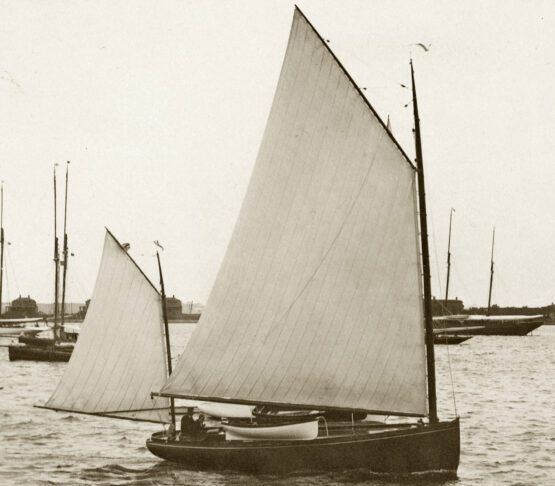
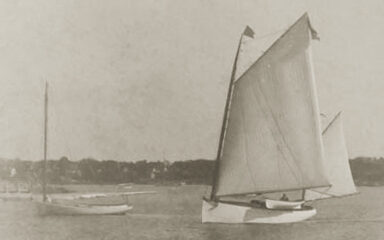
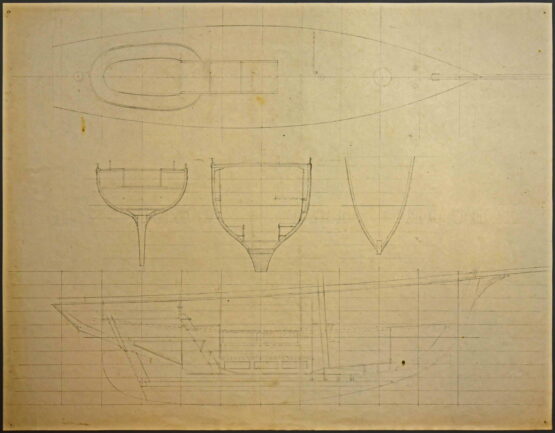

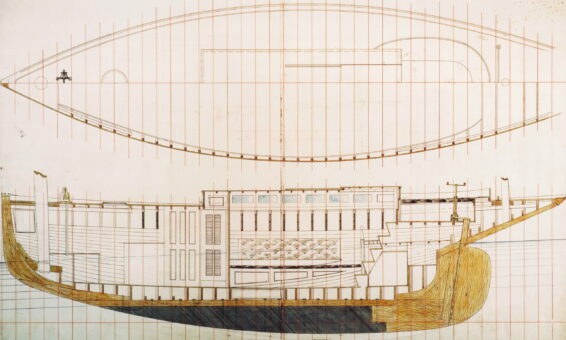
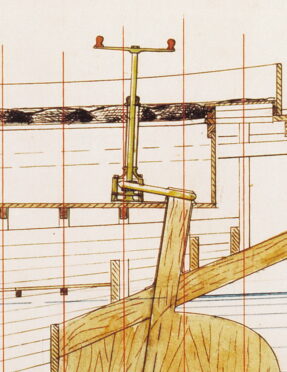
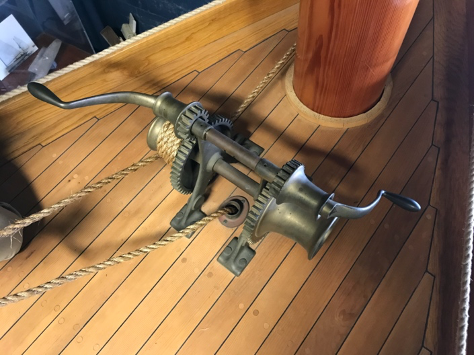
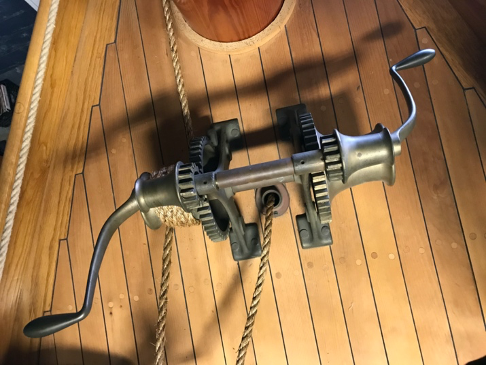


Fascinating article. The historical scope and detailed inventions and designs with original sketches convey the reader to a time when men, mind and machine were well married, pleasure was tangible, and wood mattered. Thank you to Messrs. Herreshoff and Bray!
My maternal grandfather, Frank Arthur Sayles of Pawtucket knew Francis L. and visited the boatyard in Bristol several times.
I must stop reading articles like this because they make me dream of building a replica, maintaining all the charm and efficiency of the original, but taking advantage of Carbon Fibre for the spars and modern glues to lighten the construction still further with moulded ply planking, etc.
Memo – Keep buying those lottery tickets.